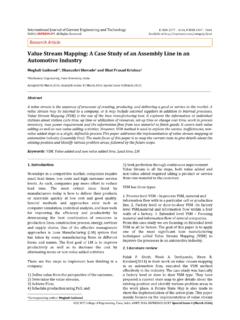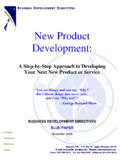Transcription of BLS STUDY SYLLABUS - califeforce.com
1 BLS STUDY GUIDE Introduction to Adult Chain of Survival The AHA has adopted, supported, and helped develop the concept of emergency cardiovascular care (ECC) systems for many years. The term Chain of Survival provides a useful metaphor for the elements of the ECC systems concept. The 5 links in the adult Chain of Survival are: Immediate recognition of cardiac arrest and activation of the emergency response system. Early cardiopulmonary resuscitation (CPR) with an emphasis on chest compressions Rapid defibrillation Effective advanced life support Integrated post-cardiac arrest care Although basic life support is taught as a sequence of distinct steps to enhance skills retention and clarify priorities, several actions should be accomplished simultaneously when multiple rescuers are present.
2 Introduction to the Pediatric Chain of Survival Although in adults cardiac is often sudden and results from a cardiac cause, in children cardiac arrest is often secondary to respiratory failure and shock. Identifying children with these problems is essential to reduce the likelihood of pediatric cardiac arrest and maximize survival and recovery. Therefore, a prevention link is added in the pediatric Chain of Survival: Prevention of arrest Early high-quality bystander CPR Rapid activation of the EMS (or other emergency response) system Effective advanced life support (including rapid stabilization and transport to definitive care and rehabilitation) Integrated post-cardiac arrest care Change in Sequence: C-A-B, Not A-B-C The 2010 AHA Guidelines for CPR and ECC recommend a change in the BLS sequence of steps from A-B-C (Airway, Breathing, Chest Compression) to C-A-B (Chest compressions, Airway, Breathing) for adults, children, and infants.
3 This changes in CPR sequence requires reeducation of everyone who has ever learned CPR, but the consensus of the authors and experts involved in creating the 2010 AHA Guidelines for CPR and ECC is that the change is likely to improve survival. By changing the sequence to C-A-B, rescuers can start chest compressions sooner, and the delay in giving breaths should be minimal (only the time required to deliver the first cycle of 30 chest compressions, or approximately 8 seconds or less; for 2-rescuers infant or child CPR, the delay will be even shorter). Emphasis on High-Quality CPR The 2010 AHA Guidelines for CPR and ECC once again emphasize the need for high-quality CPR including: A compression rat of at least 100/min (this is a change from approximately 100/min) A compression depth of a least 2 inches (5cm) in adults and a compression depth of a least one third of the anterior-posterior diameter of the chest in infants and children.
4 This is approximately 1 inches (4cm) in infants and 2 inches (5cm) in children. Note that the range of 1 to 2 inches is no longer used for adults, and the absolute depth specified for children and infants is deeper than in previous versions of the AHA Guidelines for CPR and ECC. BLS STUDY SYLLABUS Revised 04/2011 6 Allowing complete chest recoil, minimizing interruptions in compressions, and avoiding excessive ventilation continue to be important components of high-quality CPR. To further strengthen the focus on high-quality CPR, the 2010 AHA Guidelines for CPR and ECC stress the importance of training using a team approach to CPR. The steps in the BLS Algorithm have traditionally been presented as a sequence to help a single rescuer prioritize actions.
5 There is increased focus on providing CPR as a team because resuscitations in most EMS and healthcare systems involve teams of rescuers, with rescuers performing several actions simultaneously. For example, one rescuer activates the emergency response system while a second begins chest compressions, a third is either providing ventilations or retrieving the bag-mask for rescue breathing, and a fourth is retrieving a defibrillator and preparing to use. No Look, Listen, and Feel Another key change is the removal of look, listen, and feel for breathing from the assessment step. This step was removed because bystanders often failed to start CPR when they observed agonal gasping. The healthcare provider should not delay activating the emergency response system but should check the victim for 2 things simultaneously; response and breathing.
6 With the new chest compression-first sequence, the rescuer should activate the emergency response system and begin CPR if the adult victim is unresponsive and not breathing or not breathing normally (only gasping) and has no pulse. For the child or infant victim, CPR is performed if the victim is unresponsive and not breathing or only gasping and has no pulse. For all victims of all ages (except newborns), begin CPR with compressions (C-A-B sequence0. After each set of chest compressions, open the airway and give 2 breaths. Understanding the Basics of BLS BLS Consists of these main parts Chest compressions Airway Breathing Defibrillation Distinct from the lone responder approach, many workplaces and most EMS and in-hospital resuscitations involve teams of providers who should perform several actions simultaneously (eg.))
7 One rescuer activates the emergency response system while a second rescuer begins chest compressions, a third is either providing ventilations or retrieving the bag-mask for rescue breathing, and a fourth is retrieving a defibrillator and preparing to use it). Overview of Initial BLS Steps The four basic steps of BLS are: Assess the victim for a response and look for normal or abnormal breathing. If there is no response and not breathing or no normal breathing (ie, only gasping), shout for help If you are alone, activate the emergency response system and get an AED (or defibrillator) if available and return to the victim Check the victim s pulse (take at least 5 but no more than 10 seconds) If you do not definitely feel a pulse within 10 seconds, perform 5 cycles of compressions and breaths (30:2 ratio), starting with compressions (C-A-B sequence).
8 BLS STUDY SYLLABUS Revised 04/2011 7 Assessment and Scene Safety The first rescuer who arrives at the side fo the victim must quickly be sure that the scene is safe. The rescuer then check the victim for a response: Make sure the scene is safe for you and the victim. You do not want to become a victim yourself. Tap the victim s shoulder and shout, Are you all right? Check to see if the victim is breathing. If a victim is not breathing or not breathing normally (ie, only gasping), you must activate the emergency response system. Agonal gasps are not normal breathing. Agonal gasps may be present in the first minutes after sudden cardiac arrest. A person who gasps usually looks like he is drawing air in very quickly. The mouth may be open and the jaw, head, or neck may move with gasps.
9 Gasps may appear forceful or weak and some time may pass between gasps because they usually happen at a slow rate. Activate the Emergency Response System and Get an AED If you are alone and find an unresponsive victim not breathing, shout for help. If no one responds, activate the emergency response systems, get an AED if available, and then return to the victim to check a pulse and begin CPR (C-A-B sequence). Pulse Check Healthcare providers should take no more than 10 seconds to check for a pulse. To perform a pulse check in the adult, palpate a carotid pulse. If you do not definitely feel a pulse within 10 seconds, start chest compressions. To locate the carotid artery pulse: Locate the trachea, using 2 or 3 fingers Slide these 2 or 3 fingers into the groove between the trachea and the muscles at the side fo the neck, where you can feel the carotid pulse Feel for a pulse for at least 5 but no more than 10 seonds.
10 If you do not definitely feel a pulse, begin CPR, starting with chest compressions (C-A-B sequence). Begin Cycles of 30 Chest Compressions and 2 Breaths (CPR) The lone rescuer should use the compression-ventilation ratio of 30 compressions to 2 breaths when giving CPR to victims of any age. When you give chest compressions, it is important to push the chest hard and fast, at a rate of at least 100 compressions per minute, allow the chest to recoil completely after each compression, and minimize interruptions in compressions. Begin with chest compressions. The foundation of CPR is chest compressions. Follow these steps to perform chest compressions in and adult: Position yourself at the victim s side Make sure the victim is lying faceup on a firm, flat surface. If the victim is lying facedown, carefully roll him faceup.




